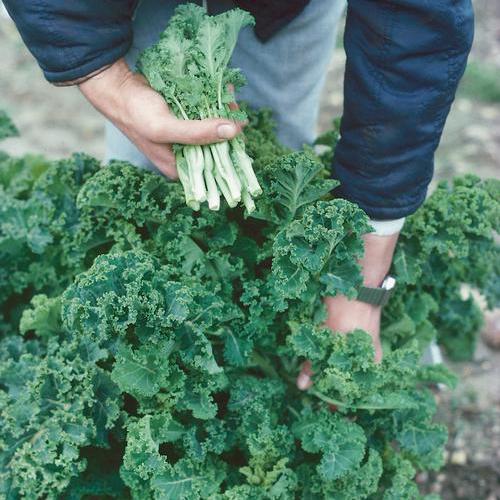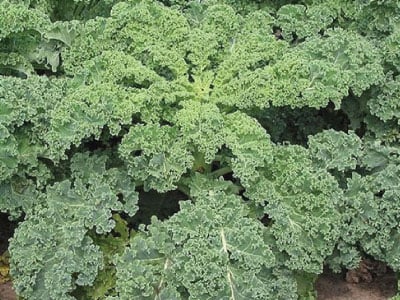
Learning Download: How to Grow Kale
From Seed to Harvest: A guide to growing kale.
Health nuts everywhere can grow their own kale, as it is an easy crop to grow. The leafy green vegetable is commonly known as a cool-weather crop best for growth in the spring and fall seasons, but kale is hardy and can adapt to warmer environments.
To plant:
Kale can be sown directly into the garden two weeks before the last frost date. Plant seeds 1/4 inch deep and 3 inches apart in rows set 18 inches apart. For a fall crop, plant kale seeds in the late summer.
To grow:
Once seedlings appear, thin them to 8 to 12 inches apart. Water regularly to keep the soil moist, as this keeps the leaves crisp and sweet. mulch around the plants to prevent dirt sticking to the leaves of the kale and potentially rotting it.
To harvest:
Kale can be grown to its full size or harvested when the leaves are small and tender. Kale is ready to harvest when its leaves are the size of your hand. It usually takes up to 95 days for kale to be ready after planting it from seed. Don’t pick the terminal bud at the top of the plant, but harvest one fistful of leaves each time you pick the kale. Kale can grow until temperatures reach 20 degrees, and frost adds to the taste. The small, tender leaves can be eaten raw. When using, cut up the larger leaves and remove the ribs prior to cooking.
What kale craves:
Upon planting the seeds, fertilize with a 5-10-10 fertilizer. Mix 1/5 cups of fertilizer with the top 3 to 4 inches of soil for a 25-foot row of kale. Throughout its growing season, you can fertilize kale with a side dressing of compost every six to eight weeks.
Where to buy kale seeds:
You can find many varieties of kale seeds, some with curled leaves and others with red stems at Urban Farmer.
Learning Download: Common pests and diseases: Kale
Common pests and diseases: Kale
When growing vegetables, it is always exciting to care for the plant throughout its growing phase and harvest it for delicious recipes later on, but one thing to watch out for is pests and diseases. Different plants are susceptible to different types of pests and diseases, and it is important to make yourself aware so you can keep a watchful eye and also take any preventative methods to keep your plants safe throughout their lifespan.
Kale can fall victim to several different pests and diseases, many of which are similar to the problems affecting greens.
Pests:
Some of the pests commonly affecting kale include the beet armyworm, cabbage aphids, cabbage loopers and more.
The beet armyworm will cause leaves to appear skeletonized due to heavy feeding. Use organic methods to control this insect such as Bacillus thuringiensis.
Cabbage aphids can stunt plant growth and even cause death. The insects are gray-green and will be visible on the leaves. These aphids only feed on cruciferous plants but can survive on related weeds. If the infestation isn’t bad, prune out the affected leaves. however, if the infestation is heavy, spray the sturdier plants with a strong jet of water to knock the aphids off the leaves.
Cabbage loopers will cause extensive damage in the leaves. The caterpillars are green and have white lines on each side of their body. They will overwinter in crop debris. Handpick the larvae off the plants, or apply Bacillus thuringiensis to kill the younger larvae.
 Diseases:
Diseases:
Some of the most common diseases affecting kale include Alternaria leaf spot, anthracnose, damping off, downy mildew and others.
Alternaria leaf spot will cause small spots on the kale’s leaves which will then turn brown or gray. These spots may becomes brittle and then crack it in the center. To prevent this, plant pathogen-free seeds, rotate crops regularly and apply appropriate fungicides when needed.
Anthracnose will cause small circular dry spots that are gray or tan in color on the leaves. If there are too many spots, the leaves can die. This is caused by a fungus that can overwinter in leaf debris and on weeds. The disease prefers to emerge in moist, warm conditions. Treat seeds with hot water prior to planting, practice crop rotation and plant seeds in an area that has adequate soil drainage.
Damping off causes seedlings to die after germination. The stem will appear constricted and twisted. This disease is more likely to appear in seedlings when temperatures are cool.
Downy mildew will cause irregular yellow patches on stems which then turn light brown. There will be gray growth on the bottom of the leaves. The disease prefers to emerge when the conditions are cool and moist. To manage this disease, remove all crop debris after you harvest the kale. Also practice regular crop rotation and apply appropriate fungicides when needed.

